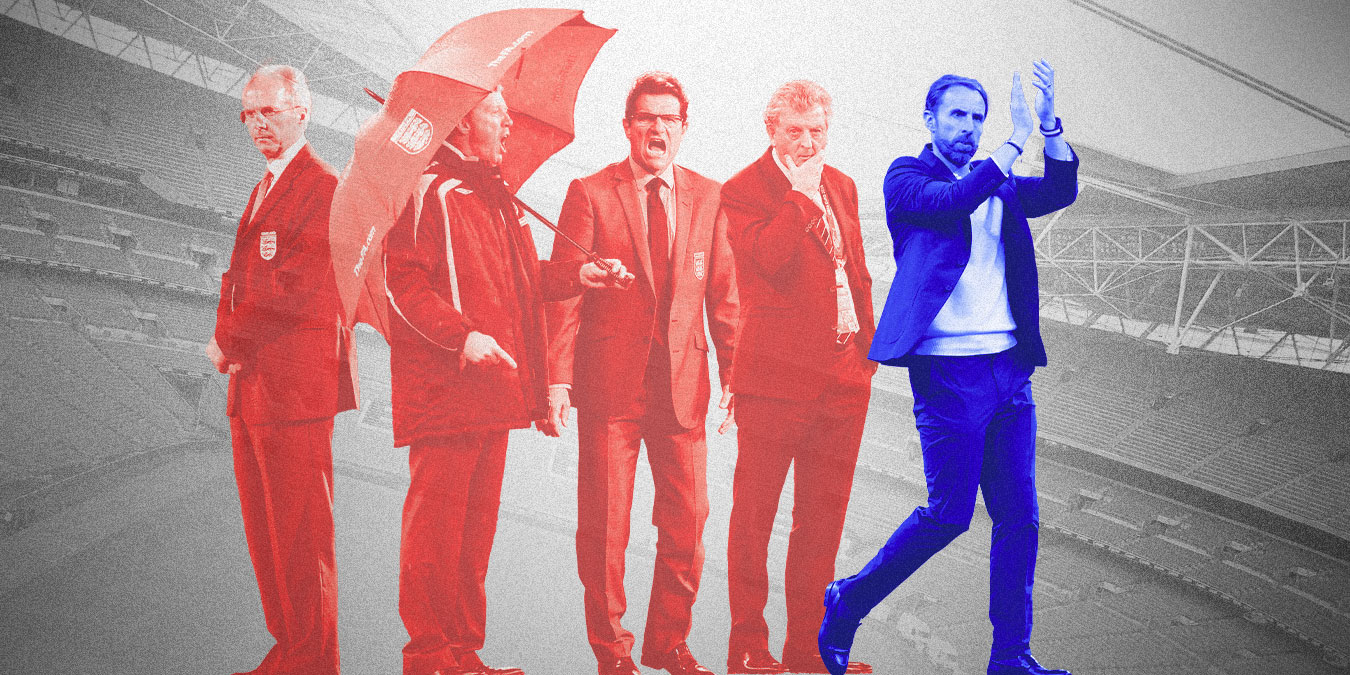For years, England were associated with “kick and rush” football. While his Three Lions may not be perfect, Gareth Southgate has all but killed such an association.
Gareth Southgate was pretty clear about the vision for his England team when taking over in 2016; he wanted to bring the Three Lions into the modern era by establishing an identifiable style of play that revolved around possession.
“Anyone who has seen the Under-21s will know I like my teams to have a lot of possession, but we can’t be without a goal threat,” he said in his first press conference as boss over seven and a half years ago. “I believe we have good players that can play a high-pressing game that will excite supporters.”
Most would certainly scoff at the idea England have excited fans at Euro 2024, because their matches have largely been dull and the team lacking in invention. But they are now preparing for a second successive European Championship final, and there were some positive signs during the 2-1 semi-final defeat of the Netherlands, with Southgate’s men producing a dominant first-half display and playing their most fluent football of the tournament when it mattered most.
As for making England a possession-focused team, however, it was also another example of how Southgate has generally succeeded in that sense – for what it’s worth.
England enjoyed 58.3% of the ball against the Oranje, taking their average share of the ball for the tournament to 57.9%. Going back as far as 1980, it’s the third-highest possession figure the Three Lions have had at a major tournament.
Now, “third-highest” might not be the payoff expected when talking about Southgate succeeding in establishing a possession-based style of play, philosophy or whatever you want to call it. But it serves as a sort of confirmation that he’s achieved what he set out to in that sense, having set a new benchmark at the 2022 World Cup.
In Qatar, England averaged 63.6% possession – that’s their highest figure on record for a major tournament, and while their average at Euro 2024 is obviously a little lower, it still reflects the largely successful continuation of Southgate’s ideals.
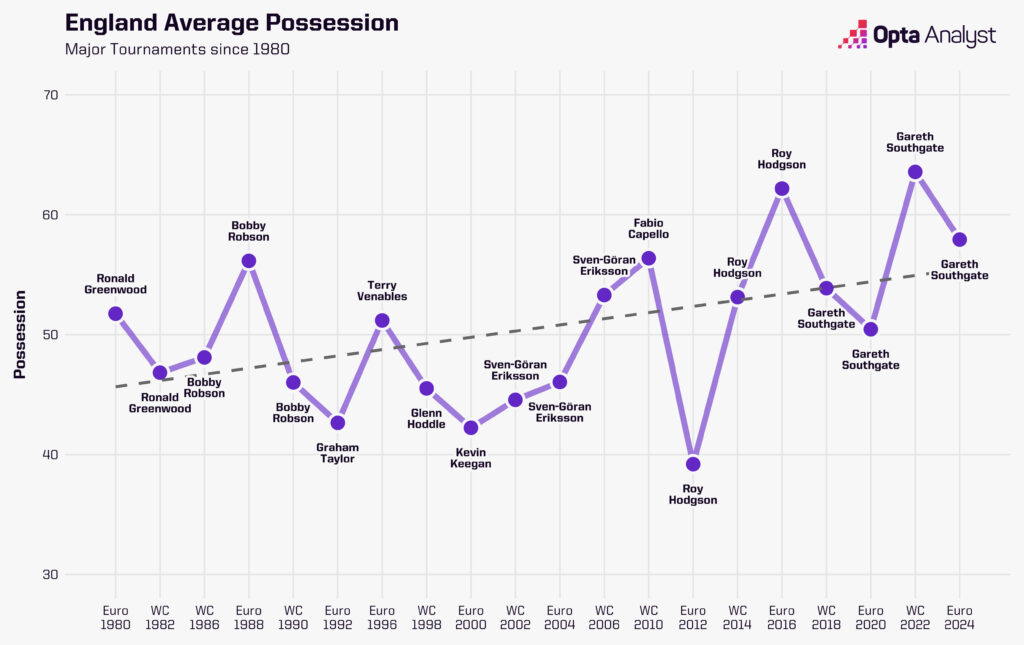
Of course, it’s not like Southgate is the first England manager to ever see his team dominate the ball in a game. Even Fabio Capello’s Three Lions enjoyed an average possession share of 58.6% in qualifying for the 2010 World Cup; the difference is the level of opposition they’re now comfortable controlling possession against.
The semi-final win over the Netherlands was a good example. They’re obviously not the best Dutch side ever, but they still got to the last four, they have a very capable squad and manager, and they’re comfortably the strongest opposition England have faced in the tournament. Also, at the 2022 World Cup, England had 57.2% of the ball against France in the quarter-finals and were unfortunate to lose.
The point is, for years England were accused of cowering to possession-based sides or teams of a similar/slightly higher level – even since Southgate took over. Look back to the 2018 World Cup; their performances against Belgium in the group stage and Croatia in the semi-final were thoroughly underwhelming and much of that was put down to an inability assert control.
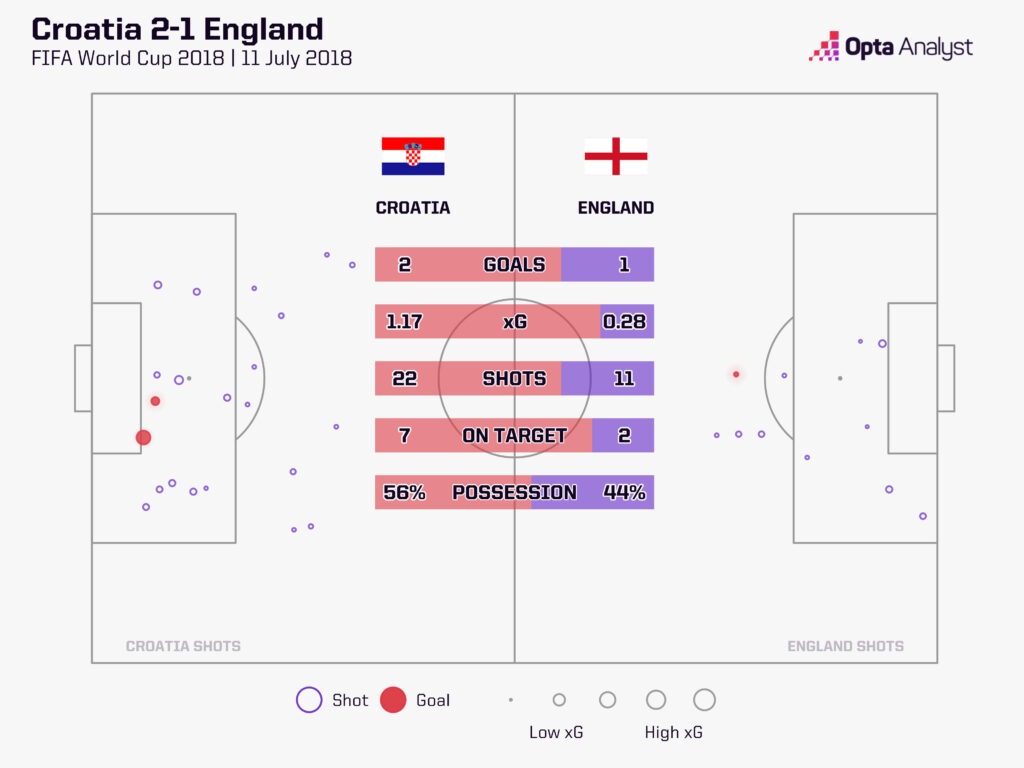
Similar could be said of their display in the Euro 2020 final penalties defeat to Italy, when they had just 34.6% of the ball after taking an early lead.
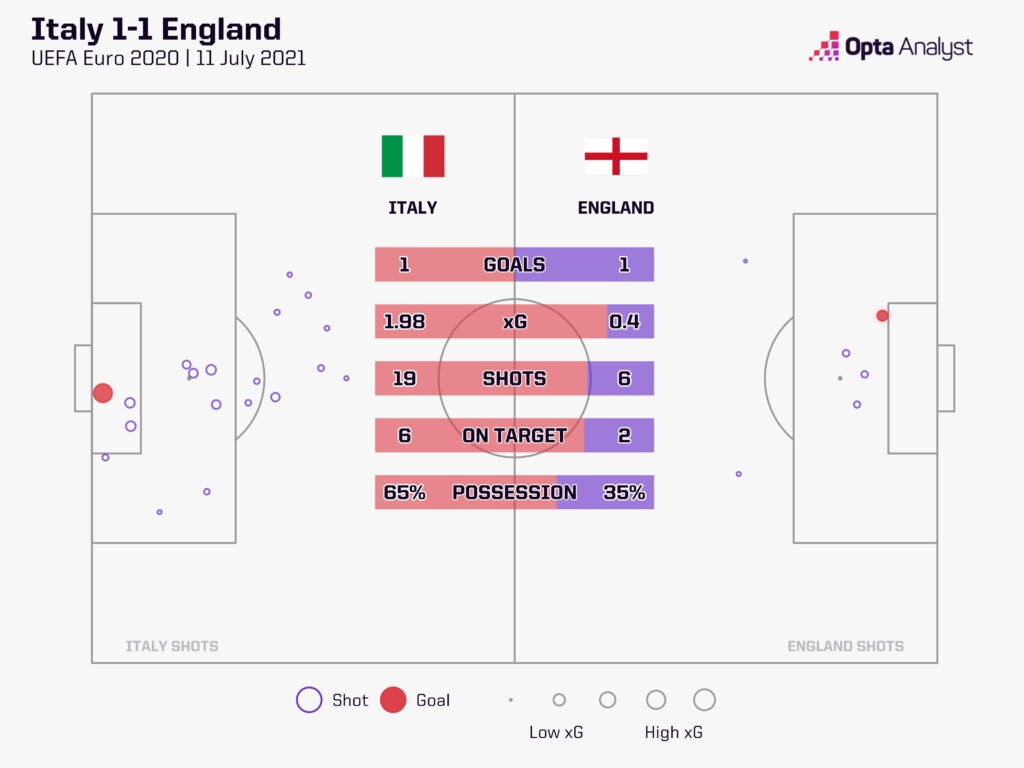
It could be suggested England teams of yesteryear lacked belief or conviction. Say what you want about the level of excitement Southgate’s team provides, but he wanted to create a team in a certain image, and it would seem he’s well on the way to accomplishing that – if he hasn’t already.
Implementing a possession-focused style of play has been long and arduous for England.
Southgate’s predecessor (well, if we ignore the solitary game Sam Allardyce took charge of), Roy Hodgson, might argue he began mapping out the path to possession football for England. His team certainly saw a lot of the ball, with their 62.2% possession at Euro 2016 being England’s second-highest on record and a huge uptick from the 39.2% recorded in his first tournament, Euro 2012.
Contributing to that Euro 2016 figure was the 69.7% against a Wales team that showed little adventure after going ahead, and the 68% in the shock 2-1 loss to Iceland. And yet, despite the possession stats of that tournament, Hodgson rarely provided the assurance that this was the plan.
There seemed to be a reluctance to this style from Hodgson. Two years earlier, he said of his philosophy: “I think we preach positivity in our attacking play, with players having the courage to get the ball and be prepared to receive the ball, even in tight situations, and, most importantly, be prepared to look forward. I’m certainly not in favour of 500 passes, of which 460 are between your goalkeeper and back four.”
It was an extreme scenario he outlined but appeared to shine a light on his attitude. As such, it lends credence to the idea that possession became a fall-back for that team because they lacked the creative talent to break teams down.
In fact, ahead of a Euro 2016 qualifier, Hodgson went as far as to suggest England could be dominated by Norway; it’s highly unlikely Southgate would have such a lack of belief in his own possession-based system.
Nevertheless, perhaps Hodgson’s reign and Euro 2016 had to happen. Maybe bringing expectations down to an all-time low helped Southgate take the team to a new level, and at the same time offered a hint of promise in terms of there being a group of players at least more accustomed to the idea of keeping hold of the ball for longer. After all, you’ve got to start somewhere.
For a long time, England were – in the eyes of many – ideologically linked to direct, “kick and rush” football. Even when their teams didn’t actually play that way, they arguably didn’t have the strength of identity to kill the association.
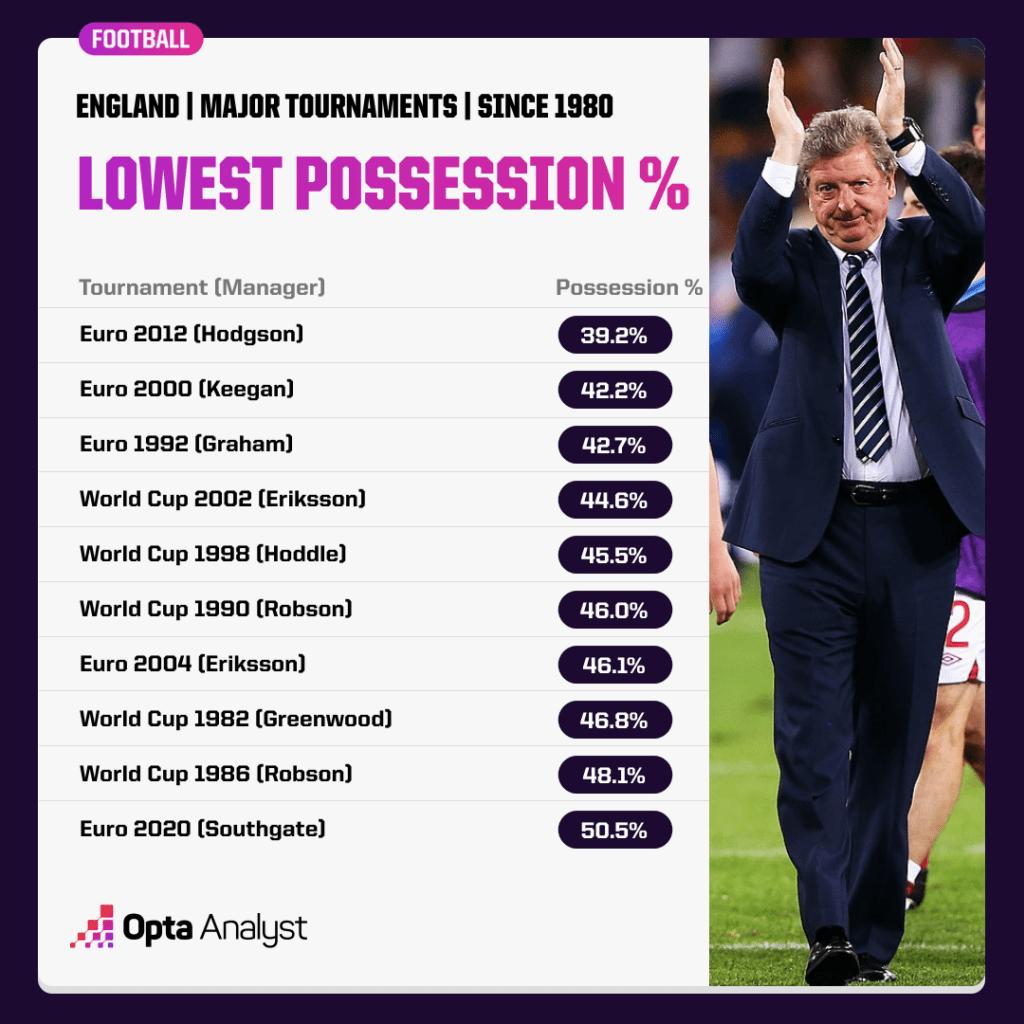
Sven-Göran Eriksson was largely regarded as a pragmatist; possession dominance certainly wasn’t something associated with his teams – at least not at major tournaments, anyway. In two of his three World Cups/Euros in charge, England averaged under 50% of the ball, recording just 34.9% against Argentina in 2002 and 42.1% against Portugal at Euro 2004, for instance.
With Eriksson, there was undoubtedly an emphasis on individuality and star names rather than what was necessarily best for the collective; square pegs in round holes springs to mind, with Paul Scholes often used on the left wing, for example. The football was rarely pretty, but it could at least be said his teams were somewhat unlucky, narrowly losing out to 2002 World Cup winners Brazil and then finding themselves beaten on penalties by Portugal at Euro 2004 and the 2006 World Cup.
It wasn’t really until Fabio Capello’s reign that hints of possession football started creeping in for England.
In 2009, Capello said: “Modern football is about playing the ball, not only long balls but when it is possible to play the counter-attack, we have to play very quickly. The possession of the ball is very important in football today.”
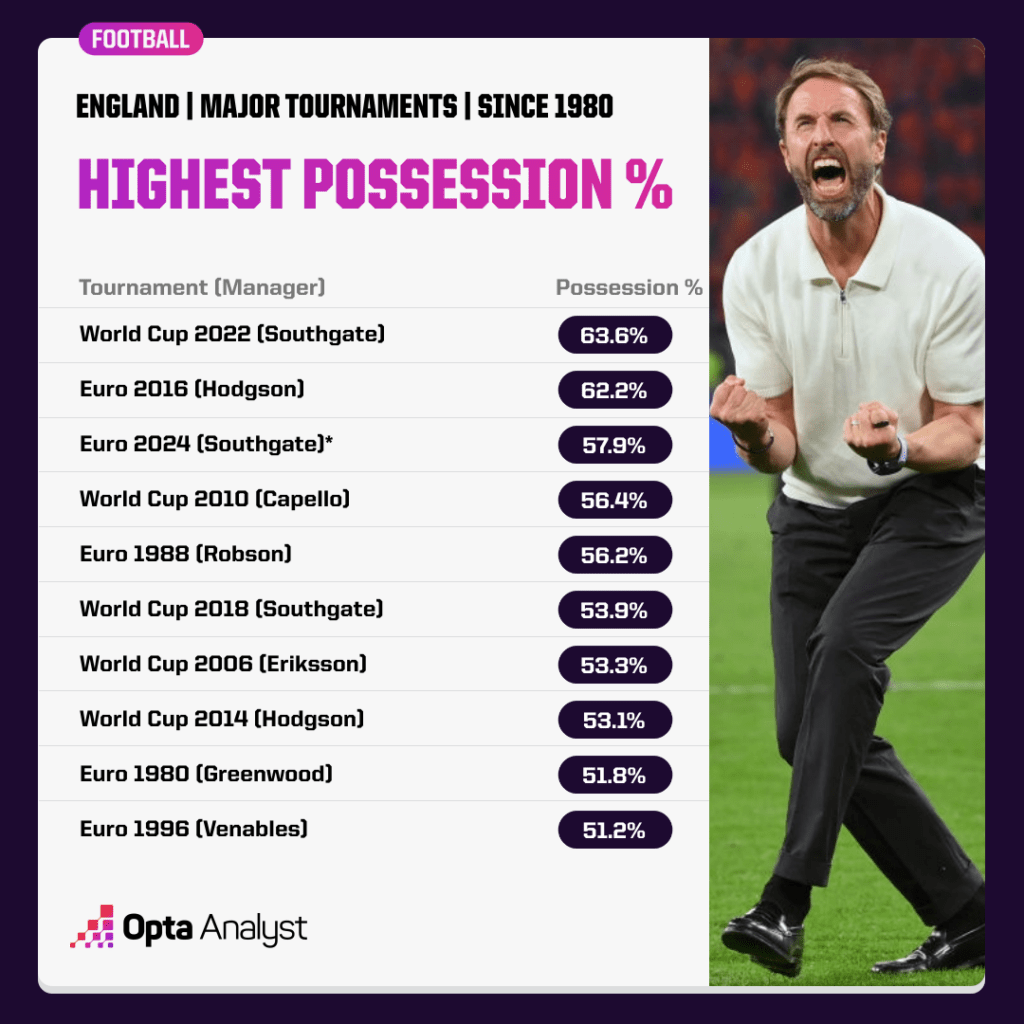
At the 2010 World Cup, Capello’s England averaged more of the ball in all four of their matches, averaging out at 56.4%. Of course, it was an unsuccessful tournament as they were roundly beaten by Germany in the last 16 (and no, we don’t think Frank Lampard’s goal-that-wasn’t would’ve made a huge difference to the outcome). And, despite their possession figures, that England side were accused of looking laborious and uninventive on the ball, especially compared to the fluid Germany side that battered them 4-1 and looked so deadly in transition.
“It looked to me as if the English have gone backwards into the bad old days of kick and rush. What I saw… had very little to do with football,” Germany great Franz Beckenbauer said at the time.
None of this is to say possession football is the one true way to play; nor does this mean England are always effective at it (for instance, they had 49% of the ball vs Denmark in the Euro 2024 group stage).
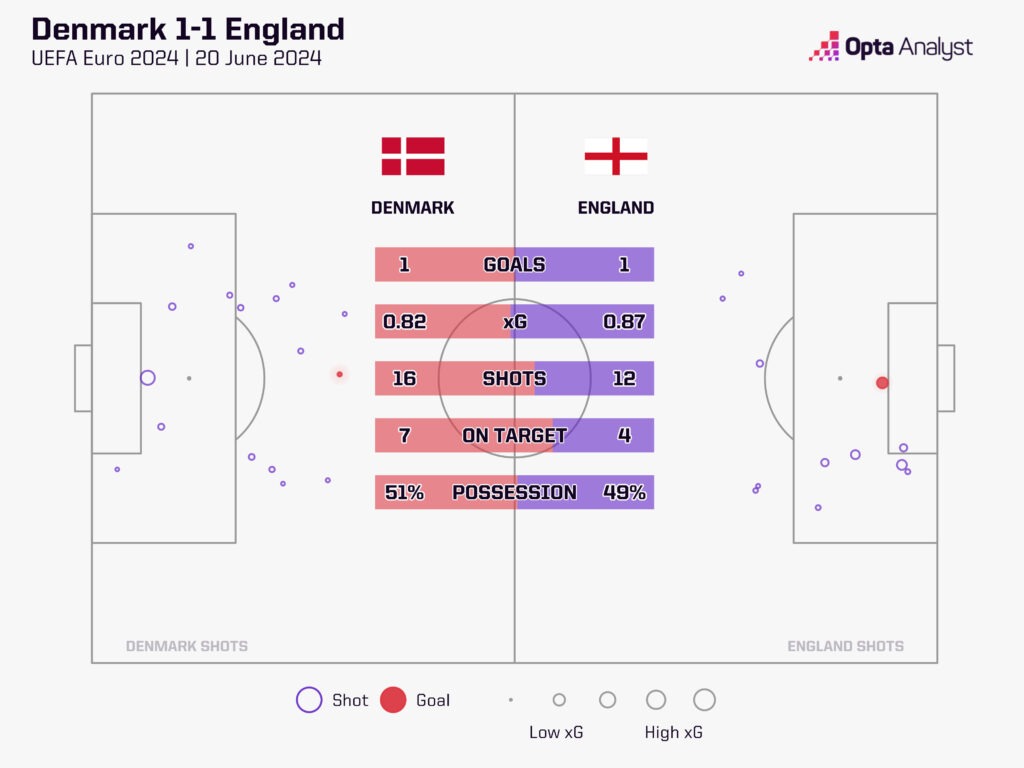
But for a long time, England became fixated with the creation of an identifiable style of play that was facilitated by technical ball-players. While by no means perfect, it’s difficult to argue that Southgate hasn’t made real strides in that sense.
All that’s lacking now is tangible success, then Southgate’s transformation of the England men’s team will be complete.
Our football newsletter ‘Stat, Viz, Quiz’ is going all in on Euro 2024 this summer, so sign up to receive exclusive content. You should also follow our social accounts over on X, Instagram, TikTok and Facebook.
